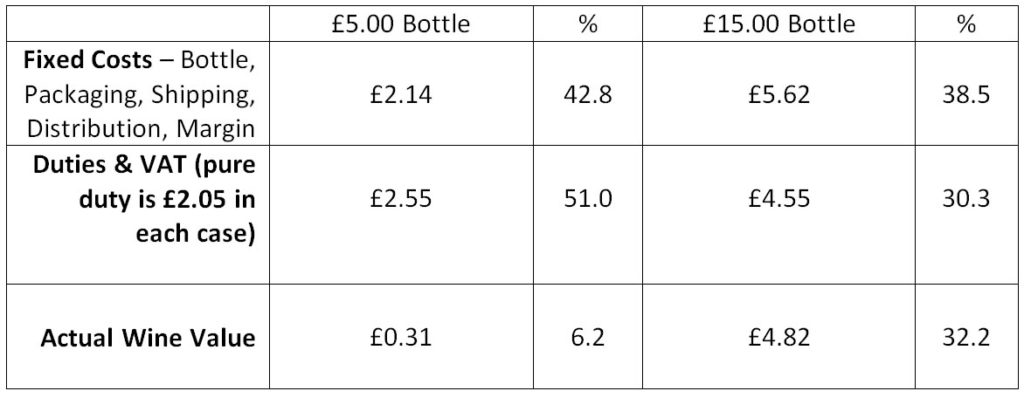
“The quality is remembered long after the price is forgotten” Sir Henry Royce
I am often asked about the price of a bottle of wine and if spending more delivers a proportionate increase in quality. Assuming you already like the style of wine in question – and a similar example is compared – then the short answer is a resounding yes! Why is this so?
To a large degree it is simple maths. The duty on a bottle of wine is the same whether it is £5.00 or £15.00 at retail. By that £2.05 of the bottle price is automatically taken up with a duty excise payment to HM Revenue & Customs – and then there is also VAT to be added on this! So duties represent 51% of the cost of a £5.00 bottle of wine, but only 30.3% of a £15.00 bottle.
Although fixed charges will also be proportionately greater in the more expensive bottle (not least they invest in better glass, cartons and closures), the proportion of cost taken up by the wine itself will therefore be far greater in the £15.00 bottle (at 32.2%, versus only 6.2% in the cheaper bottle).
Average industry figures state that the fixed costs in a £5.00 bottle (meaning costs of the bottle, label, packaging, shipping, storage, distribution and retailer margin) will be around £2.14. The duty and VAT will be £2.55, leaving just £0.31 on the wine itself! By contrast the £15.00 bottle has £4.82 in terms of pure wine value.

By contrast
In other words the investment in the very wine itself is far greater – and therefore should be of higher quality by definition. This is not to say the wine increases in a linear way (i.e. a £15 bottle may not actually be three times better than a £5 bottle), but it will be significantly and measurably better for sure.
Equally – and we must stress this fact – this doesn’t mean that a £5 wine will be bad (if well chosen of course!). We know only too well how good and popular the Borsao red Borsao Red Wine Trust 100 is in our portfolio at £5.50 per bottle. However, we have found at WineTrust100 that however hard we try and no matter how many samples we taste, examples like Borsao are actually quite rare. We simply haven’t found yet any wine which we could sell at £5 or under that would also meet our minimum 90 points quality score.
And it is worth noting that with each annual budget duties on wine will only continue to increase (and above the rate of inflation), so this subject matter is only going to get more pertinent.
One caveat to finish this review is that the formula is not exponential – when you get to wines with values in the £100’s and (yes!) £1,000’s per bottle, pricing parameters are being driven by many factors other than raw cost of goods (not least rarity, fashion, investment potential etc.). But this is purely academic – these wines are way beyond the pocket of the vast majority of us, sadly.
We all have budgets, personal preferences and pet likes/hates, but like a lot of things in life you really do notice a step up in quality if you spend a bit more. Wine is no different. In summary, and speaking personally, I like to buy wines at different price levels for different occasions – and there are times to indulge without hesitation and not least, frankly, for the sheer thrill of it.
Six of the Best
So if I may, I’ll finish with six examples from Wine Trust 100, which I feel personally endorse this principle – please try these with total confidence:
Lawson’s Marlborough Reserve Sauvignon Blanc
Donabaum Austrian Gruner Veltliner
Il Passo Sicilian Red
Briego Ribrera del Duero Crinza red
Rosa dei Frati Italian Rosé
Chateau Laville Sauternes Dessert Wine 1/2 bottle

